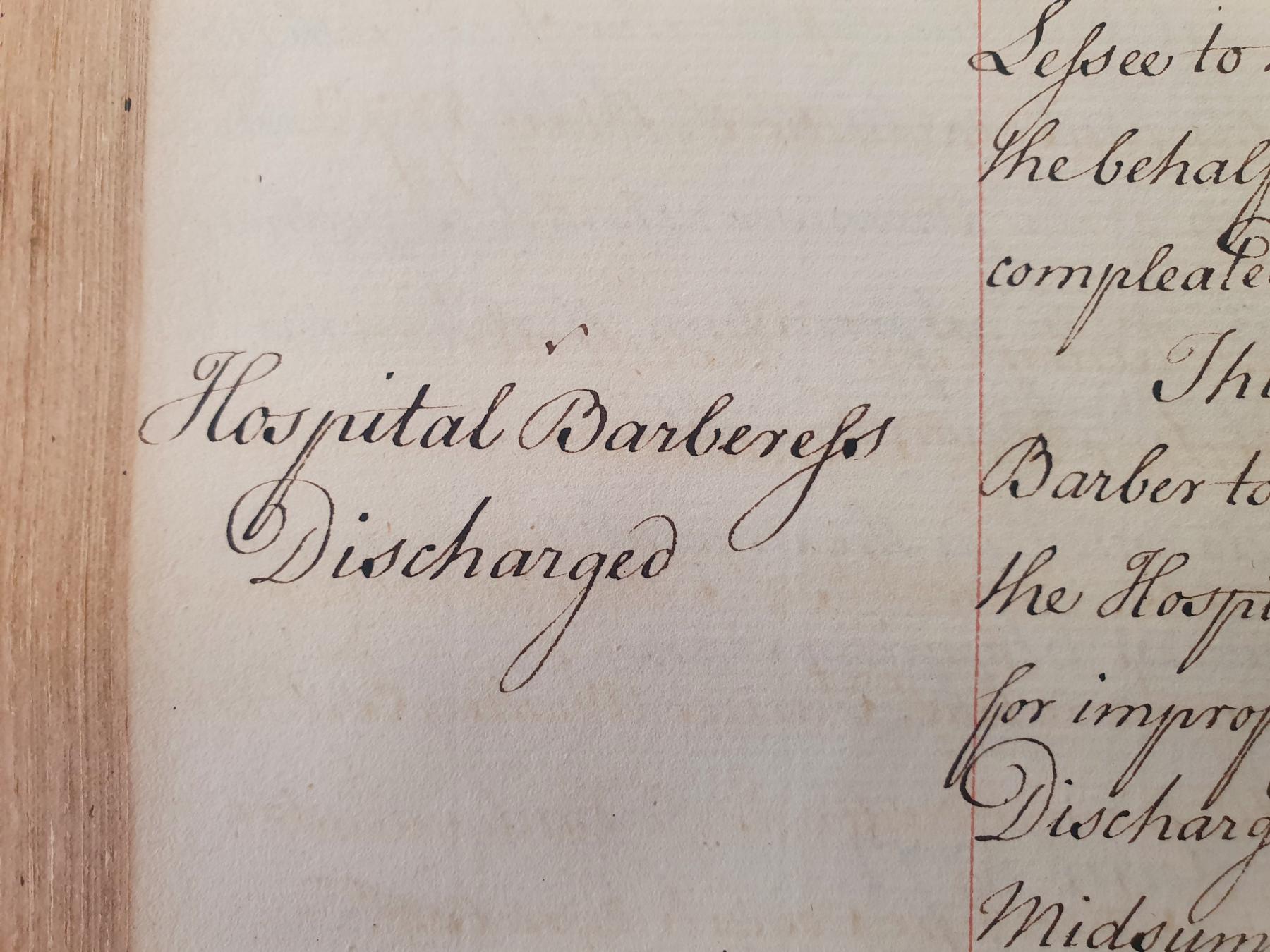A final cut: the Barberess of Barts

This week has seen the official end of the Barts 900 year, which kicked off on 24 March 2023, the 900th birthday of St Bartholomew's Hospital. In a year of celebrations, the highlight for the Trust Archives was our exhibition, Life and Death in the Archives: St Bartholomew's Hospital 1123-2023, which toured three outdoor locations in the City of London from between May and September last year, including three months in the hospital square. (A smaller version of the exhibition is still on display in the hospital's King George V building).
Our curator for the exhibition was Emma Shepley. Emma's research uncovered fascinating new stories from the hospital archives and collections, including a few which didn't make it into the exhibition.
So, as a final 900th anniversary treat, and to launch our new series of blog posts from the Trust Archives, we bring you a guest post from Emma, about a character from the hospital's history for whom we have all developed a soft spot!
‘Shaving Patients by Order of the Surgeons’
On Tuesday 20 April 1760, John Darker, Treasurer of St Bartholomew’s Hospital and eight assembled gentlemen of the committee met to agree the business of the week. In the account books of Barts, archaic practices like delivering the ‘Green Staffe’ to new governors or lists of the foundling babies ‘dropt and deserted’ at the hospital gates are recorded alongside the standard business of contracts renewed, payments made, and debts collected. Item five on Tuesday’s agenda was the hospital barber:
Barbara Cripple, Barber, Additional Salary
Agreed to allow unto Barbara Cripple the Barber of the Hospital, an additional Salary of five pounds [Per] anno for the Shaving the Men Patients, to commence from Christmas 1760, in Consideration of the Increase of twenty more Men Foul Patients in the Hospital, the former Salary being twenty pounds; over & above her other allowances for Shaving Patients by Order of the Surgeons.

Hospital barbers cut and shaved patient’s heads and beards before operations and treatments. Barbara’s £5 bonus was for an influx of men with syphilis (‘Foul Patients’) who arrived when Barts closed its Lock Hospital in Hackney and transferred the patients to Smithfield where they were treated on the general wards.
This record of a senior female barber in the male-dominated medical world of Barts is intriguing, but women barbers were certainly not unknown in the 18th century. Formal apprenticeships in all trades were closed to women, but in family-run businesses, daughters and wives learned trade skills working alongside husbands and fathers and frequently carried on independently after the man’s death. This looks very likely to be the case for Barbara.
Tracing London genealogical records back three decades to 5 December 1731, a young Barbara Bewis got married at St Brides Church, Fleet Street to John Adams, a ‘barber and peruke maker’ (a peruke was a man’s powdered wig, fashionable throughout the 1700s). John worked his skilled trade in St Martin LeGrand - then a busy commercial street just round the corner from the hospital and two years later the couple had a daughter, also Barbara, baptised at St Bride’s on 16 February 1733.

After John Adam’s death, Barbara (senior) married William Cripple, a ‘watch-maker from Wood Street’. In their 16 July Fleet Prison wedding of 1750, both are listed as 'widows'. The newlyweds with stepdaughter Barbara moved next-door to the Hospital to Little Britain from 1750, renting their apartment from Barts for £10 a year. Watch-maker William died three years later, leaving twice-widowed Barbara Cripple listed in the land tax records until 1767 when she too probably dies.
As an aside, Barbara Cripple appears one final time on a scrap of paper held in the London Metropolitan Archives. In the Old Bailey records for January 1761, Barbara serves on a ‘Jury of Matrons - twelve married women with experience of childbearing summoned to court to rule if a defendant was pregnant. Barbara and her neighbours find Elizabeth Clement ‘not with quick-child’and Clement received a death sentence for theft, commuted to transportation for life on 24 February 1762 ‘to the plantations in America.’
Over a decade later, Barts Treasurer John Darker is still convening his weekly meeting and on Wednesday 1 April 1772 the minutes note:
‘Hospital Barberess discharged
This committee, considering that Barbara Adams, the present barber to this hospital is removed from her place of residence near the hospital, and that there have been Various Complaints against her for improper conduct on diverse occasions. It is ordered that she be Discharged from the said office of barber to this Hospital at Midsummer Day next, and that a new Barber be elected in her stead’.
This is very likely to be Barbara Cripple’s unmarried daughter Barbara – who has taken on the Hospital position after her mother’s death. Details of Barbara’s ‘improper conduct on diverse occasions’ are not recorded but petty theft and drunkenness are regularly cited as reasons for dismissal in other cases.
Neither Barbara can be traced further and two months later on 16 June 1772 Darker holds an election for a new Barber. The result is determined by ‘the holding up of hands’ and of the three candidates (all men), Francis Phipps and James Seabrooke are defeated and Henry Tonks is the victor, to ‘receive and enjoy all the salary, Perquisites and every other customary advantage accruing from the said office of Barber to this Hospital’.
The corridors of St Bartholomew’s Hospital have been walked by many ‘greats’ – real and fictional, from William Harvey, discoverer of the circulation of blood to Sherlock Holmes meeting Watson in Barts Chemical Laboratory. But these is something deeply satisfying about finding new people like Barbara, who have no biographies, no portraits, and no commemorative plaques. They are compelling, but fugitive - a whole life glimpsed in a line or two of ink and then gone.
